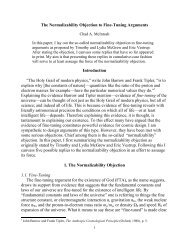Theism and Explanation - Appeared-to-Blogly
Theism and Explanation - Appeared-to-Blogly
Theism and Explanation - Appeared-to-Blogly
You also want an ePaper? Increase the reach of your titles
YUMPU automatically turns print PDFs into web optimized ePapers that Google loves.
Notes 187<br />
this be a fatal objection? In any case, it does so only if we think that a<br />
cause must be both a necessary <strong>and</strong> suffi cient condition of its effect. But<br />
as Mackie argues (Cement of the Universe, 62), a cause may contribute<br />
<strong>to</strong> an effect without being a suffi cient condition of it. It may be merely<br />
an INUS—“an insuffi cient but non-redundant part of an unnecessary but<br />
suffi cient”—condition.<br />
23. Swinburne, Existence of God, 42.<br />
24. Does this solve the causal deviance problem? I think it does, since it means<br />
that an act is not intentional unless it is caused by the agent’s unconditional<br />
judgement that this “is <strong>to</strong> be done.” But a further solution might start with<br />
the idea that intentional behaviour is sensitive <strong>to</strong> certain facts, <strong>and</strong> that causally<br />
deviant action lacks this sensitivity (Bishop, Natural Agency, 148–50).<br />
25. Dennett, Intentional Stance, 16.<br />
26. Ibid., 16–17.<br />
27. Ibid., 49.<br />
28. Davidson, “On the Very Idea of a Conceptual Scheme,” 197.<br />
29. Davidson, “Psychology as Philosophy,” 237.<br />
30. Ibid., 236–37.<br />
31. Dennett, Intentional Stance, 50.<br />
32. Føllesdal, “Rationality Assumptions,” 316.<br />
33. Popper, “Models, Instruments, <strong>and</strong> Truth,” 178.<br />
34. The rationality principle, as we have seen, acts as a constraint on such explanations,<br />
for as Schueler writes (Reasons <strong>and</strong> Purposes, 130 n.), “there will<br />
almost always be numerous, confl icting, or even inconsistent interpretations<br />
of any action, each of which will make some sense of it.” What we are looking<br />
for is the interpretation that assumes the highest degree of rationality<br />
(Dennett, Intentional Stance, 21).<br />
35. Audi, Practical Reasoning, 116.<br />
36. The example is based on one of Audi’s illustrations (Practical Reasoning,<br />
114).<br />
37. For a summary of the literature, see Allen <strong>and</strong> Reber’s article of the same<br />
name.<br />
38. Audi, Practical Reasoning, 99.<br />
39. Von Wright, <strong>Explanation</strong> <strong>and</strong> Underst<strong>and</strong>ing, 96.<br />
40. Davidson (“Actions, Reasons, <strong>and</strong> Causes,” 16) makes essentially the same<br />
point, arguing that an intentional explanation must evaluate “the relative<br />
force of the various desires <strong>and</strong> beliefs in the matrix of decision.” He concludes<br />
that the practical syllogism cannot perform this explana<strong>to</strong>ry role, since<br />
it “exhausts its role in displaying an action as falling under one reason.” This<br />
is true, but it does not prevent us from asking, <strong>and</strong> attempting <strong>to</strong> answer, the<br />
broader question.<br />
41. Audi (Practical Reasoning, 88) does recognise the possibility of “confl icting<br />
reasons.” But his basic schema does not allow us <strong>to</strong> deal with them. One<br />
could represent the different reasons by way of different practical syllogisms,<br />
but the question then arises as <strong>to</strong> how these can be integrated <strong>to</strong> produce a<br />
single intention.<br />
42. My example is loosely based on Nagel, The View from Nowhere, 115–16.<br />
43. More precisely, it will need <strong>to</strong> include a comparative evaluative premise, since<br />
some of the other premises may also express judgements of value, as we shall<br />
see in a moment.<br />
44. Schueler, Reasons <strong>and</strong> Purposes, 69.<br />
45. Ibid., 70.<br />
46. Aris<strong>to</strong>tle, Nicomachean Ethics, Bk. 7; see Audi, Practical Reasoning, 19–24.<br />
47. Davidson, “How is Weakness of Will Possible?” 21–22.



